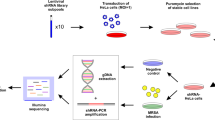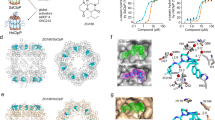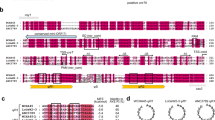Abstract
Staphylococcus aureus and other staphylococci continue to cause life-threatening infections in both hospital and community settings1,2,3. They have become increasingly resistant to antibiotics, especially β-lactams and aminoglycosides, and their infections are now, in many cases, untreatable. Here we present a non-antibiotic, non-phage method of treating staphylococcal infections by engineering of the highly mobile staphylococcal pathogenicity islands (SaPIs). We replaced the SaPIs' toxin genes with antibacterial cargos to generate antibacterial drones (ABDs) that target the infecting bacteria in the animal host, express their cargo, kill or disarm the bacteria and thus abrogate the infection. Here we have constructed ABDs with either a CRISPR–Cas9 bactericidal or a CRISPR–dCas9 virulence-blocking module. We show that both ABDs block the development of a murine subcutaneous S. aureus abscess and that the bactericidal module rescues mice given a lethal dose of S. aureus intraperitoneally.
This is a preview of subscription content, access via your institution
Access options
Access Nature and 54 other Nature Portfolio journals
Get Nature+, our best-value online-access subscription
$29.99 / 30 days
cancel any time
Subscribe to this journal
Receive 12 print issues and online access
$209.00 per year
only $17.42 per issue
Buy this article
- Purchase on Springer Link
- Instant access to full article PDF
Prices may be subject to local taxes which are calculated during checkout



Similar content being viewed by others
References
Kennedy, A.D. et al. Epidemic community-associated methicillin-resistant Staphylococcus aureus: recent clonal expansion and diversification. Proc. Natl. Acad. Sci. USA 105, 1327–1332 (2008).
King, M.D. et al. Emergence of community-acquired methicillin-resistant Staphylococcus aureus USA 300 clone as the predominant cause of skin and soft-tissue infections. Ann. Intern. Med. 144, 309–317 (2006).
Gould, I.M. et al. New insights into meticillin-resistant Staphylococcus aureus (MRSA) pathogenesis, treatment and resistance. Int. J. Antimicrob. Agents 39, 96–104 (2012).
Lindsay, J.A., Ruzin, A., Ross, H.F., Kurepina, N. & Novick, R.P. The gene for toxic shock toxin is carried by a family of mobile pathogenicity islands in Staphylococcus aureus. Mol. Microbiol. 29, 527–543 (1998).
Tallent, S.M., Langston, T.B., Moran, R.G. & Christie, G.E. Transducing particles of Staphylococcus aureus pathogenicity island SaPI1 are comprised of helper phage-encoded proteins. J. Bacteriol. 189, 7520–7524 (2007).
Tormo-Más, M.A. et al. Moonlighting bacteriophage proteins derepress staphylococcal pathogenicity islands. Nature 465, 779–782 (2010).
Ruzin, A., Lindsay, J. & Novick, R.P. Molecular genetics of SaPI1—a mobile pathogenicity island in Staphylococcus aureus. Mol. Microbiol. 41, 365–377 (2001).
Wang, H., La Russa, M. & Qi, L.S. CRISPR/Cas9 in genome editing and beyond. Annu. Rev. Biochem. 85, 227–264 (2016).
Novick, R.P. & Geisinger, E. Quorum sensing in staphylococci. Annu. Rev. Genet. 42, 541–564 (2008).
Ji, G., Beavis, R.C. & Novick, R.P. Cell density control of staphylococcal virulence mediated by an octapeptide pheromone. Proc. Natl. Acad. Sci. USA 92, 12055–12059 (1995).
Chen, J. & Novick, R.P. Phage-mediated intergeneric transfer of toxin genes. Science 323, 139–141 (2009).
Chen, J., Ram, G., Penadés, J.R., Brown, S. & Novick, R.P. Pathogenicity island-directed transfer of unlinked chromosomal virulence genes. Mol. Cell 57, 138–149 (2015).
Wright, J.S. III, Lyon, G.J., George, E.A., Muir, T.W. & Novick, R.P. Hydrophobic interactions drive ligand-receptor recognition for activation and inhibition of staphylococcal quorum sensing. Proc. Natl. Acad. Sci. USA 101, 16168–16173 (2004).
Bunce, C., Wheeler, L., Reed, G., Musser, J. & Barg, N. Murine model of cutaneous infection with gram-positive cocci. Infect. Immun. 60, 2636–2640 (1992).
Brouillette, E. et al. DNA immunization against the clumping factor A (ClfA) of Staphylococcus aureus. Vaccine 20, 2348–2357 (2002).
Ryan, E.M., Gorman, S.P., Donnelly, R.F. & Gilmore, B.F. Recent advances in bacteriophage therapy: how delivery routes, formulation, concentration and timing influence the success of phage therapy. J. Pharm. Pharmacol. 63, 1253–1264 (2011).
Winstel, V. et al. Wall teichoic acid structure governs horizontal gene transfer between major bacterial pathogens. Nat. Commun. 4, 2345–2354 (2013).
O'Flaherty, S. et al. Genome of staphylococcal phage K: a new lineage of Myoviridae infecting gram-positive bacteria with a low G+C content. J. Bacteriol. 186, 2862–2871 (2004).
Labrie, S.J., Samson, J.E. & Moineau, S. Bacteriophage resistance mechanisms. Nat. Rev. Microbiol. 8, 317–327 (2010).
Mayville, P. et al. Structure-activity analysis of synthetic autoinducing thiolactone peptides from Staphylococcus aureus responsible for virulence. Proc. Natl. Acad. Sci. USA 96, 1218–1223 (1999).
Weil, J., Cunningham, R., Martin, R. III, Mitchell, E. & Bolling, B. Characteristics of lambda p4, a lambda derivative containing 9 per cent excess DNA. Virology 50, 373–380 (1972).
Frischauf, A.M., Lehrach, H., Poustka, A. & Murray, N. Lambda replacement vectors carrying polylinker sequences. J. Mol. Biol. 170, 827–842 (1983).
Citorik, R.J., Mimee, M. & Lu, T.K. Sequence-specific antimicrobials using efficiently delivered RNA-guided nucleases. Nat. Biotechnol. 32, 1141–1145 (2014).
Bikard, D. et al. Exploiting CRISPR-Cas nucleases to produce sequence-specific antimicrobials. Nat. Biotechnol. 32, 1146–1150 (2014).
Novick, R.P. Genetic systems in staphylococci. Methods Enzymol. 204, 587–636 (1991).
Stocker, B.A. Abortive transduction of motility in Salmonella; a nonreplicated gene transmitted through many generations to a single descendant. J. Gen. Microbiol. 15, 575–598 (1956).
Ozeki, H. Chromosome fragments participating in transduction in Salmonella Typhimurium. Genetics 44, 457–470 (1959).
Arber, W. Transduction of chromosomal genes and episomes in Escherichia coli. Virology 11, 273–288 (1960).
Acknowledgements
This work was supported by NIH grant R01-AI22159 to RPN and by a grant-in-aid from NYU School of Medicine. The animal experiments described in this paper were conducted in conformity with all relevant ethical regulations, under IACUC protocol 160722-01, approved by the NYUSOM IACUC on 7/21/16.
Author information
Authors and Affiliations
Contributions
R.P.N., H.F.R. and G.R. planned and discussed the experiments. H.F.R. had the initial idea; G.R. and H.F.R. did the cloning; G.R. performed the in vitro tests; I.R.-P. and R.P.N. did the mouse experiments; D.J. did the DNA preparations; and R.P.N. did the microbiological work and wrote the manuscript.
Corresponding authors
Ethics declarations
Competing interests
A patent application has been filed by New York University, with G.R., H.F.R. and R.P.N. as inventors, on the basis of results presented in this paper.
Supplementary information
Supplementary Tables
Supplementary Tables 1–4 (PDF 349 kb)
Rights and permissions
About this article
Cite this article
Ram, G., Ross, H., Novick, R. et al. Conversion of staphylococcal pathogenicity islands to CRISPR-carrying antibacterial agents that cure infections in mice. Nat Biotechnol 36, 971–976 (2018). https://doi.org/10.1038/nbt.4203
Received:
Accepted:
Published:
Issue Date:
DOI: https://doi.org/10.1038/nbt.4203
This article is cited by
-
CRISPR-Cas System: A New Dawn to Combat Antibiotic Resistance
BioDrugs (2024)
-
In vivo bioluminescence imaging of natural bacteria within deep tissues via ATP-binding cassette sugar transporter
Nature Communications (2023)
-
CRISPR-Cas engineering in food science and sustainable agriculture: recent advancements and applications
Bioprocess and Biosystems Engineering (2023)
-
Gene drives gaining speed
Nature Reviews Genetics (2022)
-
Engineered CRISPR-Cas systems for the detection and control of antibiotic-resistant infections
Journal of Nanobiotechnology (2021)



